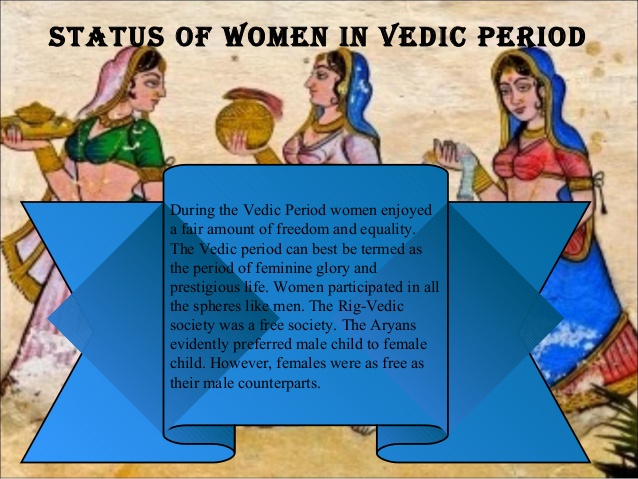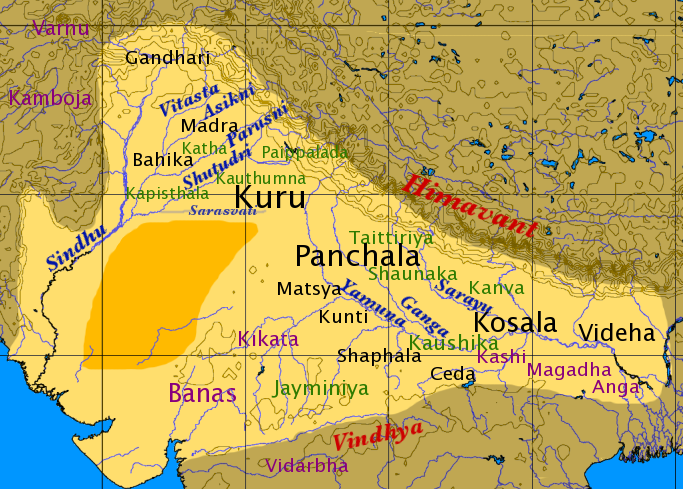Skip to content

- Rig Vedic people called themselves ‘Aryans’. They had detailed knowledge of the geographical area in which they lived. Name and location and pattern of geographical features such as rivers and mountains mentioned in Rig-Veda suggest location of the regions of the geographical area of their habitat.
- The Nadi-sukta hymn of the Rig Veda mentions 21 rivers, which include the Ganga in the east and the Kubha (Kabul) in the west.
- The pattern of rivers is given in a definite order from the east to west i.e. from the Ganga in the east to the Kubul in the west. The rivers like Yamuna, Saraswati, Sutlej, Ravi, Jhelum, and Indus are situated between Ganga and Kabul.
- The mountain namely the Himalayas and the Mujavant (as mentioned in the Veda) are located in the north.
- The Ocean i.e. ‘Samudra’ is mentioned in connection with rivers Sindhu and the river Saraswati had been falling into the ocean. Ocean has been also mentioned in the context of foreign trade.
- The geography of Rig Vedic period covers present-day western Uttar Pradesh, Haryana, Punjab, Rajasthan, Gujarat, the whole of Pakistan, and the south of Afghanistan.
- The battle of ten kings, mentioned in the Rig Veda, gives names of ten kings who participated in a war against Sudas who was Bharata king of Tritsus It illustrates that the territory known to Vedic people was divided into a number of states-republics and monarchical (kingdoms).
- The battle was fought on the bank of Parushani (Ravi) river and Sudas emerged as victorious.
- ‘Bharatvarsha’ was the name used for the whole country. It was given by the most important people of the Rig Veda. They were ‘Bharatas’ who were settled in the region between the rivers Saraswati and Yamuna.
- The Rig Veda also gives the location of other people, such as Purus in the region of Kurukshetra; the Tritsus east of Ravi; the Alinas, the Pakhtas, the Bhalanas and the Sibis west of Indus (up to Kabul river) and so on
Society
- Occupation of individuals was the basis of classification of a society in the Rig Vedic period.
- It was divided into four varnas, namely
- Brahmanas (teacher and priests);
- Kshatriya (rulers and administrators);
- Vaisya (farmers, merchants, and bankers); and
- Sudra (artisan and laborers).
- There was complete freedom and mobility for the adoption of a profession.
- Trades and occupations did not assume a hereditary character in the society (till now).
Salient Features of Vedic Society
- The family was the smallest unit of a society. It was primarily monogamous and Patriarchal.
- Child marriage was not in fashion.
- There was freedom of choice in marriage.
- A widow could marry the younger brother of her deceased husband.
- The wife was a partner of the husband in all religious and social ceremonies.
- The father’s property was inherited by son.
- The daughter could inherit it only if she was the only child of her parents.
- Right to property was known in moveable things like cattle, horse, gold, and ornament and so also in immoveable property like land and house.

Education
- The teacher was given great respect.
- The school was in the home of the teacher where he taught the particular sacred texts.
- The texts were in the first instance learnt by pupils repeating the words taught by their teacher.
- A great importance was attached to enunciation and pronunciation.
- Oral learning was the method of training.
- Students were given intense training and learning to memorize and preserve the huge mass of Vedic literature.
Food and Drinks
- The important part of the diet was milk and its products like curd, butter, and ghee. Grains were cooked with milk (kshira-pakamodanam).
- Chappati (bread) of wheat and barley was eaten mixed with ghee.
- People used to eat the meat of birds, wild animals (like boar, antelopes, and buffalo), and fish.
- The meat of animals such as sheep, goat, and buffalo etc., which were sacrificed on ceremonial occasions, was also eaten.
- The cow was mentioned as aghnyae. not to be killed. The Vedas prescribe a penalty of death or expulsion from the kingdom to those who kill or injure cows.
- Sura and Somae. alcoholic drinks were also consumed, though their consumption had been condemned.
Economic Life
- Agriculture, cattle rearing, and trade and commerce were the main economic activity of the Rig Vedic people.
- People had domestic animals like cows, sheep, goats, asses, dogs, buffalos etc.
- Oxen were used for ploughing and drawing carts and horses for drawing the chariots.
- The plough was drawn by the oxen at times in a team of six, eight, or even twelve.
- The grains were harvested with sickles.
- Manure was used for high yield; irrigation was also practiced.
- Excess of rains and drought is mentioned as damaging the crops.
- The grains are collectively called ‘Yava’ and ‘Dhanya.’
- Some other occupations were pottery-making, weaving, carpentry, metal working, leather-working, etc.
- Initially, copper was the only metal that was used and the general term ‘ayas’ had been used for this. In a later period, terms like ‘lohit ayas’ and ‘syam ayas’ were used for copper and iron respectively.
- The trade and traders (vanik) were also known in the Rig Vedic era.
- The practices of exchange of goods (Barter Economy) were in trend. It has been found that ten cows were quoted as the price for an image of Indra.
- The use of money can be traced in the mention of a gift of 100 nishkas.
- Money-lending was also popular. It is mentioned that an eighth or a sixteenth part of one being paid either as an interest or part of the principle.
- The sea is mentioned in the context of trade and ocean wealth, like pearls, and shells.
- Politics of Vedic India was well structured and organized.
Political Structure
- The political structure of Rig Vedic India can be studied in the following ascending order −
- The Family (Kula), the smallest unit.
- The Village (Grama)
- The Clan (Vis)
- The People (Jana)
- The Country (Rashtra)
- Kula (family) included all the people living under the same roof (griha).
- A collection of several families constitutes the grama (village) and its headman was called gramini.
- The collection of several grama (village) was called as the Vis and its head was called Vispati.
- Several Vis constituted a Jana as it is mentioned as Panchajanah, Yadva-janaha, and Bharata-janaha.
- The aggregation of all Jana constitutes Rashtra (country).
Administration
- The hereditary kings were the popular form of Government.
- The provision of a democratically elected king by the assembly of people Jana was also known.
- The Rashtra was small states ruled by a raja (king).
- The bigger kingdoms were ruled by ‘samrat’ that reflects that they enjoyed a position of greater authority and dignity.
- The Raja administered justice with the assistance of Purohita and other officials.
- The Raja was offered bali, which was voluntary gift or tribute for his services. The bali was offered by his own people and also from defeated people.
- The crimes were strongly dealt with by the administration. Major crimes were theft, burglary, robbery, and cattle lifting.
- The important royal officials were −
- Purohita (chief priest and minister)
- Senani (army chief)
- Gramini (head of a village)
- Dutas (envoys)
- Spies (spy)
- Sabha and Samiti were two important assemblies mentioned in the Rig Veda. These assemblies were forms the essential feature of the government.
- The Samiti was mainly dealt with the policy decisions and political business, included common people.
- The Sabha was a selected body of the Elders or Nobles and less political in character.





नदी>NADI>ನಾಡಿ!!!